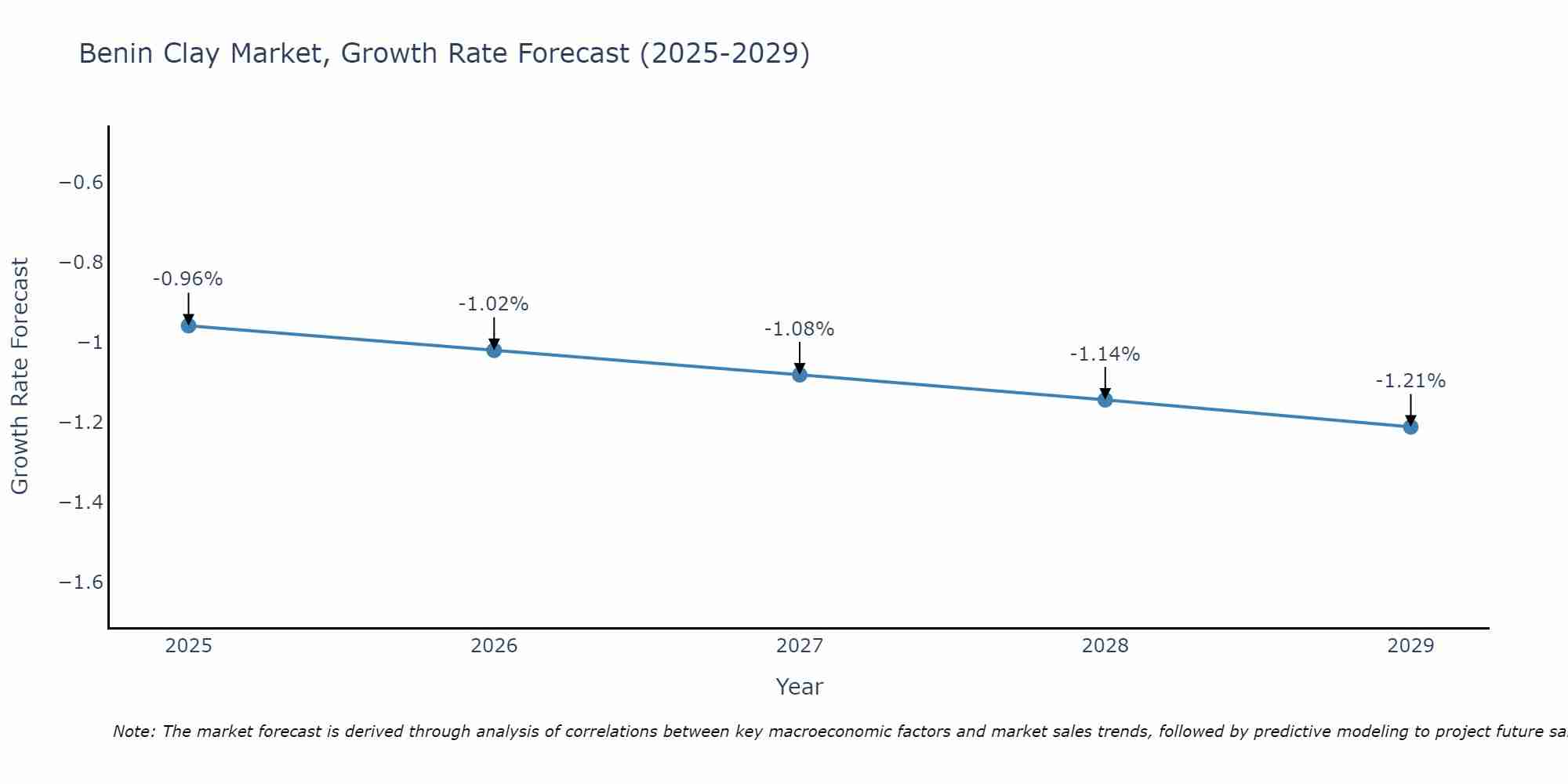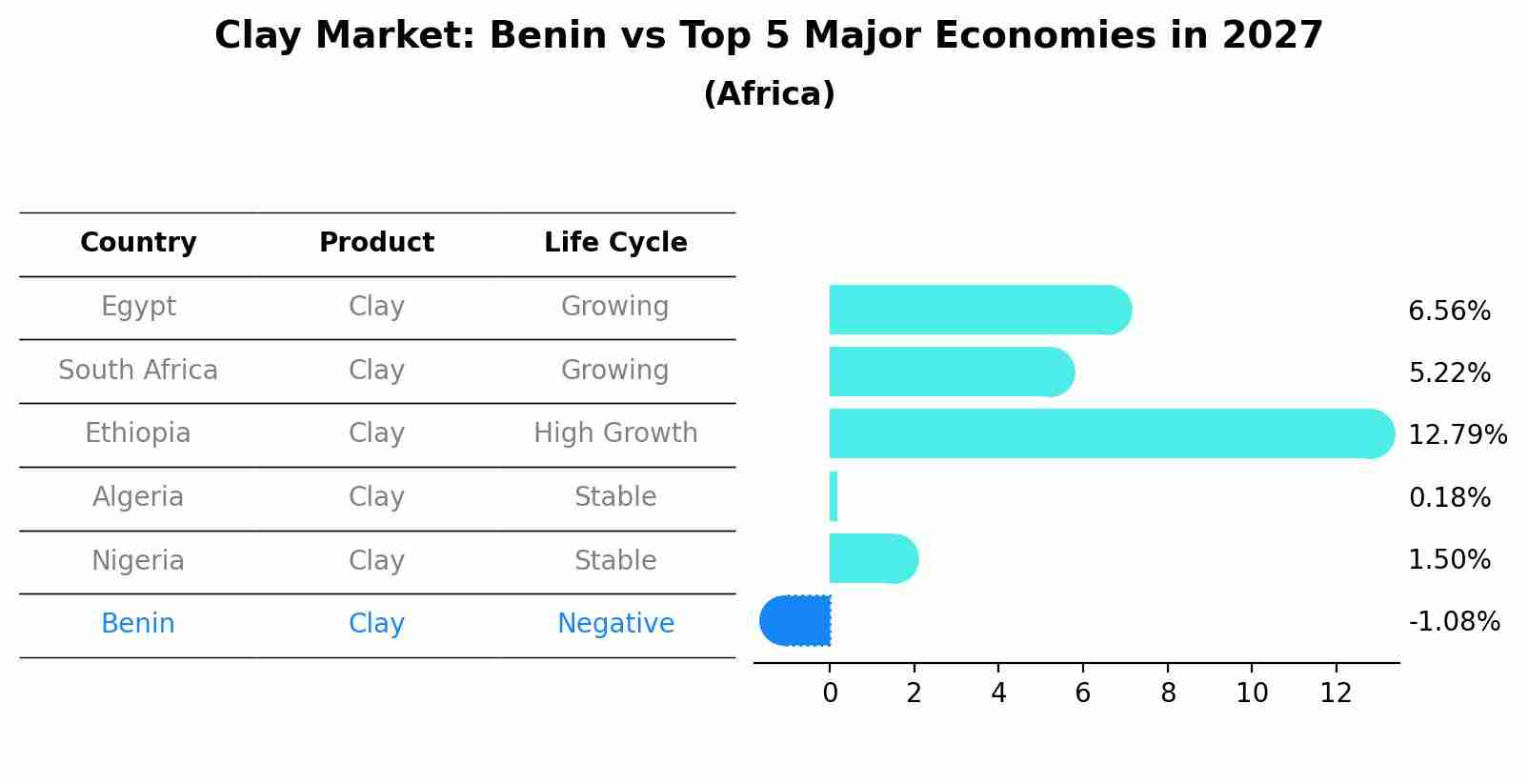Benin Clay Market (2025-2031) | Size, Value, Industry, Share, Analysis, Growth, Outlook, Forecast, Companies, Segmentation, Trends & Revenue
| Product Code: ETC5257628 | Publication Date: Nov 2023 | Updated Date: Sep 2025 | Product Type: Market Research Report | |
| Publisher: 6Wresearch | No. of Pages: 60 | No. of Figures: 30 | No. of Tables: 5 | |
Benin Clay Market Size Growth Rate
The Benin Clay Market could see a tapering of growth rates over 2025 to 2029. Starting high at -0.96% in 2025, the market steadily declines to -1.21% by 2029.

Clay Market: Benin vs Top 5 Major Economies in 2027 (Africa)
The Clay market in Benin is projected to grow at a negative growth rate of -1.08% by 2027, within the Africa region led by Egypt, along with other countries like South Africa, Ethiopia, Algeria and Nigeria, collectively shaping a dynamic and evolving market environment driven by innovation and increasing adoption of emerging technologies.

Benin Clay Market Overview
The clay market in Benin is significant for its applications in ceramics, construction, and industrial processes. The market is driven by the demand for high-quality clay materials used in pottery, bricks, tiles, and as additives in various industrial applications.
Drivers of the market
The Benin Clay market benefits from the diverse applications of clay in construction, ceramics, and industrial processes. Clay is used as a raw material in the production of bricks, tiles, and pottery, as well as in various industrial applications such as drilling and paper manufacturing. The growth of the construction and ceramics industries, coupled with the increasing demand for high-quality and specialty clays, drives market growth. Additionally, advancements in clay processing technologies and the expanding use of clay in new applications contribute to market expansion.
Challenges of the market
The clay market in Benin encounters challenges such as limited local production and processing capabilities. Clay is used in various applications including ceramics, construction, and agriculture, and its production requires specialized equipment and infrastructure. The lack of local manufacturing facilities means that the market relies heavily on imports, driving up costs. Additionally, there is competition from alternative materials and fluctuations in global prices that can affect market growth.
Government Policy of the market
Government policies in the clay market focus on promoting the sustainable extraction and use of clay resources. This includes regulations on mining practices, quality standards for clay products, and incentives for local producers. The government also supports research into innovative uses of clay and encourages the development of eco-friendly clay-based products. Policies aim to balance resource use with environmental protection and support the growth of the ceramics and construction industries.
Key Highlights of the Report:
- Benin Clay Market Outlook
- Market Size of Benin Clay Market, 2024
- Forecast of Benin Clay Market, 2031
- Historical Data and Forecast of Benin Clay Revenues & Volume for the Period 2021-2031
- Benin Clay Market Trend Evolution
- Benin Clay Market Drivers and Challenges
- Benin Clay Price Trends
- Benin Clay Porter`s Five Forces
- Benin Clay Industry Life Cycle
- Historical Data and Forecast of Benin Clay Market Revenues & Volume By Application for the Period 2021-2031
- Historical Data and Forecast of Benin Clay Market Revenues & Volume By Tableware for the Period 2021-2031
- Historical Data and Forecast of Benin Clay Market Revenues & Volume By Sanitary ware for the Period 2021-2031
- Historical Data and Forecast of Benin Clay Market Revenues & Volume By Medical applications for the Period 2021-2031
- Historical Data and Forecast of Benin Clay Market Revenues & Volume By End Use for the Period 2021-2031
- Historical Data and Forecast of Benin Clay Market Revenues & Volume By Ceramic and for the Period 2021-2031
- Historical Data and Forecast of Benin Clay Market Revenues & Volume By Non-ceramic for the Period 2021-2031
- Benin Clay Import Export Trade Statistics
- Market Opportunity Assessment By Application
- Market Opportunity Assessment By End Use
- Benin Clay Top Companies Market Share
- Benin Clay Competitive Benchmarking By Technical and Operational Parameters
- Benin Clay Company Profiles
- Benin Clay Key Strategic Recommendations
Frequently Asked Questions About the Market Study (FAQs):
1 Executive Summary |
2 Introduction |
2.1 Key Highlights of the Report |
2.2 Report Description |
2.3 Market Scope & Segmentation |
2.4 Research Methodology |
2.5 Assumptions |
3 Benin Clay Market Overview |
3.1 Benin Country Macro Economic Indicators |
3.2 Benin Clay Market Revenues & Volume, 2021 & 2031F |
3.3 Benin Clay Market - Industry Life Cycle |
3.4 Benin Clay Market - Porter's Five Forces |
3.5 Benin Clay Market Revenues & Volume Share, By Application, 2021 & 2031F |
3.6 Benin Clay Market Revenues & Volume Share, By End Use, 2021 & 2031F |
4 Benin Clay Market Dynamics |
4.1 Impact Analysis |
4.2 Market Drivers |
4.2.1 Increasing demand for natural and eco-friendly products in various industries |
4.2.2 Growing awareness about the benefits and applications of Benin clay in skincare and cosmetic products |
4.2.3 Rising trend of using traditional and organic ingredients in personal care and beauty products |
4.3 Market Restraints |
4.3.1 Limited availability of high-quality Benin clay due to seasonal factors and geographical constraints |
4.3.2 Lack of standardized quality control measures leading to variations in product quality |
4.3.3 Competition from synthetic alternatives and other natural clays in the market |
5 Benin Clay Market Trends |
6 Benin Clay Market Segmentations |
6.1 Benin Clay Market, By Application |
6.1.1 Overview and Analysis |
6.1.2 Benin Clay Market Revenues & Volume, By Tableware, 2021-2031F |
6.1.3 Benin Clay Market Revenues & Volume, By Sanitary ware, 2021-2031F |
6.1.4 Benin Clay Market Revenues & Volume, By Medical applications, 2021-2031F |
6.2 Benin Clay Market, By End Use |
6.2.1 Overview and Analysis |
6.2.2 Benin Clay Market Revenues & Volume, By Ceramic and, 2021-2031F |
6.2.3 Benin Clay Market Revenues & Volume, By Non-ceramic, 2021-2031F |
7 Benin Clay Market Import-Export Trade Statistics |
7.1 Benin Clay Market Export to Major Countries |
7.2 Benin Clay Market Imports from Major Countries |
8 Benin Clay Market Key Performance Indicators |
8.1 Number of new product launches incorporating Benin clay |
8.2 Percentage increase in the use of Benin clay in skincare and cosmetic formulations |
8.3 Rate of adoption of Benin clay in industries beyond beauty and personal care |
8.4 Average price trends of Benin clay compared to other natural clays |
8.5 Number of research studies highlighting the benefits and applications of Benin clay |
9 Benin Clay Market - Opportunity Assessment |
9.1 Benin Clay Market Opportunity Assessment, By Application, 2021 & 2031F |
9.2 Benin Clay Market Opportunity Assessment, By End Use, 2021 & 2031F |
10 Benin Clay Market - Competitive Landscape |
10.1 Benin Clay Market Revenue Share, By Companies, 2024 |
10.2 Benin Clay Market Competitive Benchmarking, By Operating and Technical Parameters |
11 Company Profiles |
12 Recommendations | 13 Disclaimer |
- Single User License$ 1,995
- Department License$ 2,400
- Site License$ 3,120
- Global License$ 3,795
Search
Related Reports
- ASEAN and Thailand Brain Health Supplements Market (2025-2031) | Strategy, Consumer Insights, Analysis, Investment Trends, Opportunities, Growth, Size, Share, Industry, Revenue, Segments, Value, Segmentation, Supply, Forecast, Restraints, Outlook, Competition, Drivers, Trends, Demand, Pricing Analysis, Competitive, Strategic Insights, Companies, Challenges
- ASEAN Bearings Market (2025-2031) | Strategy, Consumer Insights, Analysis, Investment Trends, Opportunities, Growth, Size, Share, Industry, Revenue, Segments, Value, Segmentation, Supply, Forecast, Restraints, Outlook, Competition, Drivers, Trends, Demand, Pricing Analysis, Competitive, Strategic Insights, Companies, Challenges
- Europe Flooring Market (2025-2031) | Outlook, Share, Industry, Trends, Forecast, Companies, Revenue, Size, Analysis, Growth & Value
- Saudi Arabia Manlift Market (2025-2031) | Outlook, Size, Growth, Trends, Companies, Industry, Revenue, Value, Share, Forecast & Analysis
- Uganda Excavator, Crane, and Wheel Loaders Market (2025-2031) | Strategy, Consumer Insights, Analysis, Investment Trends, Opportunities, Growth, Size, Share, Industry, Revenue, Segments, Value, Segmentation, Supply, Forecast, Restraints, Outlook, Competition, Drivers, Trends, Demand, Pricing Analysis, Competitive, Strategic Insights, Companies, Challenges
- Rwanda Excavator, Crane, and Wheel Loaders Market (2025-2031) | Strategy, Consumer Insights, Analysis, Investment Trends, Opportunities, Growth, Size, Share, Industry, Revenue, Segments, Value, Segmentation, Supply, Forecast, Restraints, Outlook, Competition, Drivers, Trends, Demand, Pricing Analysis, Competitive, Strategic Insights, Companies, Challenges
- Kenya Excavator, Crane, and Wheel Loaders Market (2025-2031) | Strategy, Consumer Insights, Analysis, Investment Trends, Opportunities, Growth, Size, Share, Industry, Revenue, Segments, Value, Segmentation, Supply, Forecast, Restraints, Outlook, Competition, Drivers, Trends, Demand, Pricing Analysis, Competitive, Strategic Insights, Companies, Challenges
- Angola Excavator, Crane, and Wheel Loaders Market (2025-2031) | Strategy, Consumer Insights, Analysis, Investment Trends, Opportunities, Growth, Size, Share, Industry, Revenue, Segments, Value, Segmentation, Supply, Forecast, Restraints, Outlook, Competition, Drivers, Trends, Demand, Pricing Analysis, Competitive, Strategic Insights, Companies, Challenges
- Israel Intelligent Transport System Market (2025-2031) | Strategy, Consumer Insights, Analysis, Investment Trends, Opportunities, Growth, Size, Share, Industry, Revenue, Segments, Value, Segmentation, Supply, Forecast, Restraints, Outlook, Competition, Drivers, Trends, Demand, Pricing Analysis, Competitive, Strategic Insights, Companies, Challenges
- Uganda Precast and Aggregate Market (2025-2031) | Strategy, Consumer Insights, Analysis, Investment Trends, Opportunities, Growth, Size, Share, Industry, Revenue, Segments, Value, Segmentation, Supply, Forecast, Restraints, Outlook, Competition, Drivers, Trends, Demand, Pricing Analysis, Competitive, Strategic Insights, Companies, Challenges
Industry Events and Analyst Meet
Our Clients
Whitepaper
- Middle East & Africa Commercial Security Market Click here to view more.
- Middle East & Africa Fire Safety Systems & Equipment Market Click here to view more.
- GCC Drone Market Click here to view more.
- Middle East Lighting Fixture Market Click here to view more.
- GCC Physical & Perimeter Security Market Click here to view more.
6WResearch In News
- Doha a strategic location for EV manufacturing hub: IPA Qatar
- Demand for luxury TVs surging in the GCC, says Samsung
- Empowering Growth: The Thriving Journey of Bangladesh’s Cable Industry
- Demand for luxury TVs surging in the GCC, says Samsung
- Video call with a traditional healer? Once unthinkable, it’s now common in South Africa
- Intelligent Buildings To Smooth GCC’s Path To Net Zero













